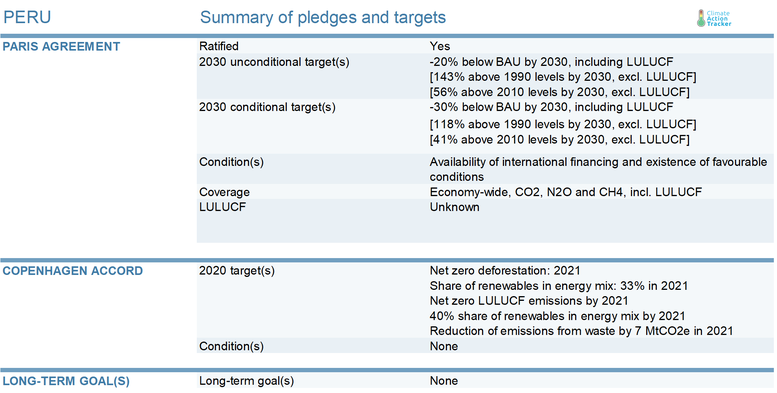Pledges And Targets
Summary table

Paris Agreement targets
NDC update: In December 2020, Peru submitted a second NDC. Our analysis of its new target is here.
Peru ratified the Paris Agreement on 25 July 2016. In its NDC, the government of Peru proposes two targets: an unconditional reduction by 20% below a BAU scenario in 2030 and a conditional (on international finance) reduction of 30% below BAU scenario in the same year, both including LULUCF (Government of Peru, 2015b). The regulation of the framework law on climate change (approved at the end of 2019), makes Peru’s Paris Agreement pledge legally binding (SINIA, 2020).
In its NDC, total emissions under the BAU scenario are projected to reach 298 MtCO2e in 2030, with LULUCF emissions accounting for 53% of overall national emissions. Total emissions excl. LULUCF are projected to reach 145 MtCO2e by 2030. Thus, we estimate the NDC targets for 2030 excluding LULUCF, as follows:
- Unconditional target: 131 MtCO2e by 2030, which is 143% above 1990 levels (56% above 2010 levels)
- Conditional target: 116 MtCO2e by 2030, which is 118% above 1990 levels (41% above 2010 levels)
According to government reports, mitigation actions in the forestry sector will ensure achieving 76% and 69% of the unconditional and the conditional target, respectively (Government of Peru, 2018). This would lead to a reduction of 30-41% of LULUCF emissions only. Even if successfully implemented, the target of reducing LULUCF emissions by at least 95% below 2010 levels by 2030, as required globally for a 1.5°C-consistent pathway, is still far from being met.
Peru is currently revising its NDC target and has announced it will move from a 30% to a 35% reduction in its next submission (Ministry of Environment of Peru, 2020c). To date, there are no publicly available details on the sectoral contribution to this target. Assuming a similar share of the LULUCF sector to the overall emissions reductions as in the current NDC, we estimate the new target would be reached with the implementation of current policies, without the need to for new additional policies. This highlights an opportunity for Peru to become a frontrunner in the climate sphere by increasing its climate action and setting realistically achievable targets that are also closer in line with the temperature goals of the Paris Agreement.
2020 pledges
Peru submitted the three pledges in the shape of NAMAs (Nationally Appropriate Mitigation Actions)1 under the Copenhagen accord in June 2010 (Government of Peru, 2010) which were later refined in Peru’s communication to the UNFCCC in November 2011 in the following way (GFLAC, 2015):
- To reduce net LULUCF emissions to zero by 2021,
- To increase the share of renewables in the energy mix to at least 40% by 2021, and
- To reduce emissions in the waste sector by 7 MtCO2e in 2021 (compared to the year 2000).
It was not possible to quantify the impact of these pledges, as baselines were not available. Nonetheless, the LULUCF pledge could have a substantial impact, as the LULUCF sector currently accounts for just over half of Peru’s total GHG emissions. This pledge was not reflected in the NDC or the measures being considered under it. Recent deforestation trends, as well as the current share of renewables in the energy mix, are at odds with the achievement of these targets by 2021, unless action is scaled up substantially.
1 | Nationally Appropriate Mitigation Actions (NAMAs) are voluntary measures undertaken by developing countries to contribute to greenhouse gas emission mitigation. The concept was introduced 2007 at the 13th session of the Conference of the Parties (COP) in Bali, Indonesia.
Long-term goal
Peru does not have a long-term target, but government officials have recently announced they are aiming for a mid-century carbon neutrality target, based on four national priorities (Ministry of Environment of Peru, 2020c):
- Transformation of the energy matrix towards renewable energy;
- Electrification of the economy (less polluting transport, electromobility);
- Circular economy;
- Nature-based solutions (sustainable use of natural resources).
This is a step in the right direction: transitioning to a low-emissions development pathway in compliance with international climate change commitments. However, Peru should avoid relying on LULUCF sinks to achieve its carbon neutrality target, given the high chance of carbon loss through deforestation or natural disturbance and eventual competition for land.
Further analysis
Latest publications
Stay informed
Subscribe to our newsletter




